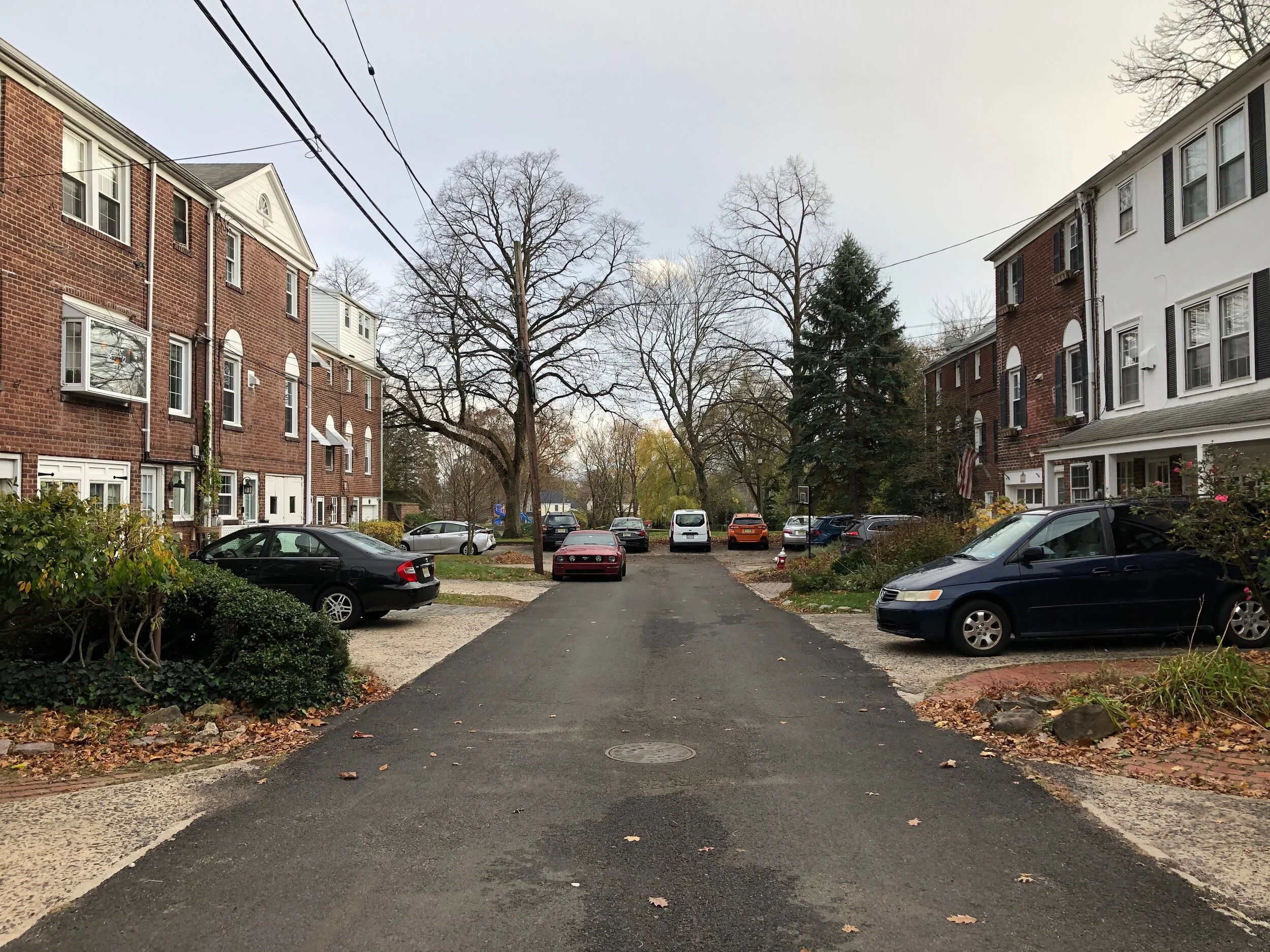Radburn (re)visited
Lessons from a post-pandemic, 15-minute, garden city
The 2020 pandemic has made us appreciate the joys of being outside while staying home. Radburn, New Jersey was designed in 1928 during the tuberculosis outbreak and following the Spanish flu pandemic. It offered pedestrians a haven for walking, separated from drivers. This fall I made my virgin trek to see what clues it holds as we consider the post-pandemic city.
—Michael King
Sketch of Radburn, Michael King 2020.
Radburn was “a town for the motor age”
The history and importance of Radburn are well known, https://en.wikipedia.org/wiki/Radburn,_New_Jersey. In a nutshell, it was meant to be separate but equal for people in cars and people on foot. The neighborhood is defined by large, common lawns, and a fairly unique alternating street network: paths for walking and streets for driving. The path network is extensive. There is a school, playgrounds, apartment buildings, and a commercial area. It is adjacent to the Radburn commuter rail station, with service to New York City.
Three lawns define the enclave, even though the southern one is set apart. Paths (green) lead to the lawns and are a way to perambulate apart from streets. One can mostly access the school and pool without crossing a road. Streets (orange) dead end at the lawns. Larger streets bisect the area in a typical suburban fashion. Towards the train station are shops and larger residential apartment buildings (flats). Housing within the locality is a mix of free-standing houses, attached townhouses and apartment buildings. The area is largely within a 10 minute (800m, 1/2 mile) walk of the train station. Unfortunately, a highway interchange directly west of Radburn, draws traffic through the area.
What does the layout and design of Radburn provoke?
The street/path separation works. Creating a green network facilitates a 15-minute-city, but we cannot let the roadway crossings ruin it.
There is much joy in the details, from the sign posts to the tunnel to the fences. Little things make a place lovely.
The desire to build more “not streets”.
Transit-adjacent does not automatically equal transit-oriented. Not tying the station directly to the lawns was a mistake.
The need for a better commercial area with more walkability, more plaza and less parking. I understand that in 1928 driving was seen as benign, but now we know its impact and dangers.
Its connection to the highway, and the through traffic it generates, diminishes the neighborhood and walkability.
The underpass connecting the two main lawns at Radburn. Excellent sight lines, fine detailing, nice arch, very “gardeny”. We need more paths like this in our daily excursions.
This is the finest “not street” at Radburn. Yes, it’s full of fall colors, but compare it to the one outside your window right now. Imagine walking home from work/school/play every day on this street.
Typical dead end street at Radburn. No curbs, minimal pavement, driveways appear to be individualized by owners. Vehicles are a bit of a hodgepodge, but that’s what you get with B streets.
Multi-family 3-story homes adjacent to the commercial area at Radburn. Path runs between the buildings to the main lawn. Good example of increasing density closer to the train station while maintaining the garden ethos.
Lawns, paths, front doors, and main streets
Radburn’s two central lawns are beauties. The school anchors one end while the other filters into the commercial area. I can imagine that the lawns are highly used by people going to and from school, walking their dogs, or walking to the train station. There is a playground and swimming pool which I’m certain are anchors and meeting points. The lawns extend into paths which lead directly to homes. Gates, benches, lawn furniture, and bikes attest to this being actively used. Two lawns are connected by an underpass, which allows one to traverse them without crossing a street. This is a key point as one considers mobility for children. I understand an overpass connecting to the third lawn was removed.
The “every other” organization of streets and paths is evident. Radburn came about during a time when practitioners were deciding how to incorporate motorized vehicles into suburban developments. Their solution was separate but equal. On one hand, streets lead to connecting roads which ultimately lead to arterials. On the other, paths lead to parks (the central lawns) which lead to the school, stores and the train station. In a sense, the streets have become the alleys - chock full of cars, asphalt and motor oil. The paths, née alleys, are where the beauty lies.
A few of the larger paths have the right-of-way of a regular street, but with no paved road In the center. Perhaps they are “not streets”. I find this concept rather appealing, as one could have typical width and separation, but no cars.
I’m curious about the front doors. Do residents consider the door which leads to the street the front door, or the one that leads to the path? I suppose it depends on whether you are more driving or walking oriented. I assume that deliveries are made via the streets, but I imagine they could just as well be made via the paths using cargo bikes. There were lots of lounge chairs, swings, fire pits, and the like on the path side of the homes. This suggests that residents recreate there happily, even though people from the community and beyond walk past. People seem content with less privacy than found in typical suburban layouts.
The commercial area needs a “Main Street update.” There are a few fine older buildings, but overall quite auto-oriented and the store scape was uninspiring. Perhaps this is a sign of the times for retail, but perhaps it is because there was nothing special. ’Tis a shame given the uniqueness of the neighborhood.
Path connecting directly to the commercial area at Radburn. This is a “mid block” crossing for traffic nerds, but just a crossing for everyone else. Important point is that the desire line is respected (as opposed to other locations where misguided traffic engineers insist that people walking are secondary citizens and thus consigned to walking way out of their way to cross the street). Unfortunately this pedestrian-oriented path leads directly into the parking lot and back door of a national chain store.
Typical path connecting to the main lawns at Radburn. Is this the town or country?
Typical path adjacent to the main lawn at Radburn. Lawn is to the left while homes are to the right, demarcated by shrubs. A fine place to stroll with your infant while listening to Taylor Swift.
Typical path between houses at Radburn. Good width, smooth and level, bounded by low permeable fences.
Fine example of a secondary path at Radburn. It connects paths to streets between sets of houses. Very tight dimensions and probably only used by the locals. Unfortunately not ADA-compliant.
Sign post on a path at Radburn. Path is named Townley and Reading because it is between Townley and Reading Streets. Clever. Not MUTCD-approved, but seriously, who cares? It’s a fine sign.
View of a house from the main lawn at Radburn. Bike, flags, toys, BBQ, garden. Idyllic.
Children and caregivers walking/scooting home from school, stopping at friends to chat/play, not worried about traffic. Ain’t life grand?
This sketch shows Radburn in 2020 with Radburn as planned. Note that the blocks near the train station were unplanned, which probably explains why they seem like a typical strip mall today. Original plan from Towards New Towns for America, C.S. Stein, Reinhold Press, 1957.
This is probably sacrilege, but Radburn is not really transit-oriented. Yes, it is adjacent to a train station, but what connections there might have been in 1928 do not really exist today. This sketch envisions a plaza at the station to anchor the neighborhood. I would introduce a series of “shared streets” to disrupt the street network and calm or eliminate motor vehicle traffic. If we have learned anything since Radburn was built, it is that once you let cars in, it is hard to make them go away.
Pedestrians First
To be able to perambulate unmolested by drivers is divine. Radburn shows how this can be done, at least partially. Radburn is also future-proofed and resilient. It came about almost 100 years ago, but seems entirely relevant today. Going forward, we need to keep putting pedestrians first!















